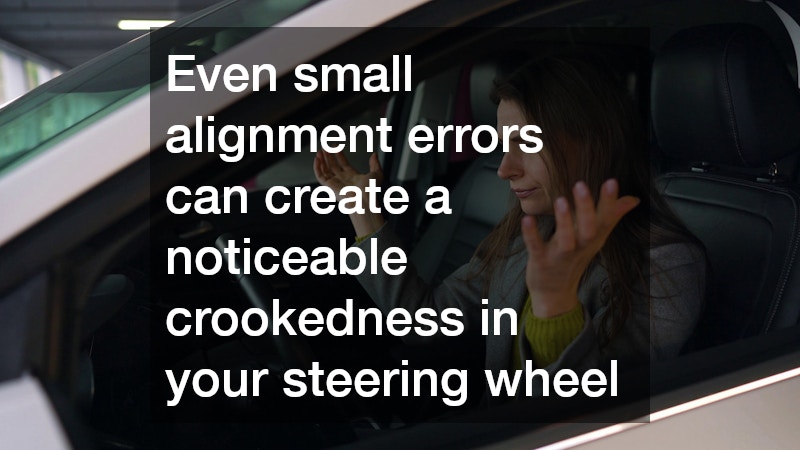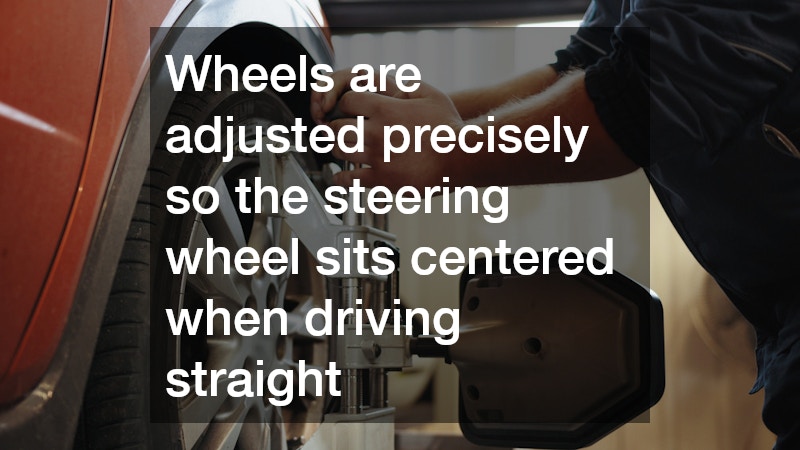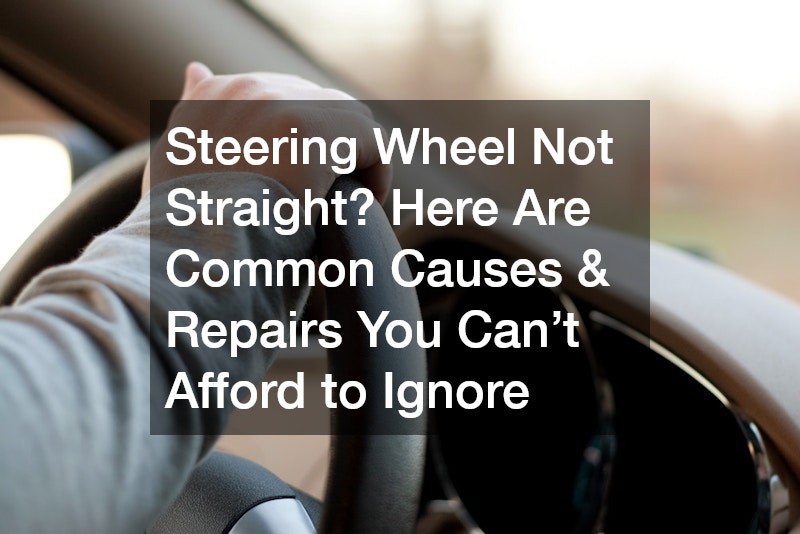- A crooked steering wheel often signals underlying issues – Most commonly wheel misalignment, worn suspension parts, or steering system problems.
- Alignment problems are the leading cause – Toe, camber, or caster misalignment can make the steering wheel sit off-center even if the car drives straight.
- Worn suspension or steering components can be dangerous – Tie rods, ball joints, bushings, and steering racks that are damaged affect handling, tire wear, and overall safety.
- Driving with a misaligned steering wheel has real risks – It can cause uneven tire wear, reduced fuel efficiency, steering strain, and compromised safety during emergency maneuvers.
- DIY checks help diagnose issues early – Inspect tire pressure, tire wear, test drive on a flat road, and listen for unusual noises to identify potential problems before visiting a mechanic.
- Prompt repairs save money and improve safety – Wheel alignment, suspension replacement, steering system repairs, or frame straightening restore proper steering, extend tire life, and prevent costly long-term damage.
- Preventive maintenance matters – Avoiding potholes, rotating tires regularly, scheduling annual alignments, and inspecting suspension parts help keep the steering wheel straight and the car safe.
If you’re driving straight ahead but your steering wheel sits slightly tilted, it’s more than just an annoyance—it’s often a warning sign that something’s off with your vehicle. Many drivers dismiss a crooked steering wheel as a minor cosmetic issue, but in reality, it can point to alignment problems, suspension wear, or even potential safety hazards. Understanding the common causes behind a misaligned steering wheel—and knowing which repairs can solve it—will save you from bigger headaches down the road.
In this guide, we’ll break down the top reasons your steering wheel isn’t sitting straight, how to diagnose the issue, and the repairs you can’t afford to ignore.
Why Does My Steering Wheel Look Crooked?
A steering wheel that isn’t centered when you’re driving straight usually signals one of two things:
- Something is wrong with the wheel alignment.
- There’s wear or damage in the steering or suspension components.
Both scenarios affect more than just your steering wheel—they impact your tires, fuel efficiency, and driving safety.
Common Causes of a Steering Wheel Not Straight

A steering wheel that doesn’t sit level when your car is moving straight usually points to something more than just cosmetic misalignment. Here are the most common culprits explained in detail.
1. Wheel Alignment Issues
This is the number one reason for a crooked steering wheel. When your wheels aren’t properly aligned, your steering wheel will naturally sit off-center even if the car seems to drive straight.
How misalignment happens:
- Hitting potholes and curbs – A sudden impact can shift the wheels’ alignment instantly.
- Everyday wear and tear – Over time, normal driving can slowly push the wheels out of alignment.
- Suspension changes – Installing new springs, shocks, or other suspension parts without a proper alignment can throw things off.
Types of misalignment:
- Toe misalignment – Think of your feet pointing slightly inward (pigeon-toed) or outward. When your car’s wheels do this, they don’t roll straight, which pulls the steering wheel off-center.
- Camber misalignment – This is the tilt of the wheels when viewed from the front. If the tops of your wheels lean inward or outward too much, you’ll not only see uneven tire wear but also feel the steering wheel shift.
- Caster misalignment – This is the forward or backward tilt of the steering axis (imagine the angle of a bicycle fork). Incorrect caster makes the wheel feel off-balance and changes how it returns to center after a turn.
Even small alignment errors can create a noticeable crookedness in your steering wheel. Left unchecked, they’ll also chew through tires prematurely.
2. Worn or Damaged Suspension Parts
Your suspension system is designed to absorb bumps and keep your wheels planted firmly on the road. When parts wear out, everything shifts slightly out of place, which throws off the steering wheel’s position.
Common suspension parts that affect alignment:
- Tie rods – Connect your steering rack to the wheels. Worn tie rods make steering sloppy and cause uneven wheel angles.
- Ball joints – Act like pivots for your wheels. If they wear out, the wheels can tilt or move more than they should.
- Control arms and bushings – Keep the wheels stable. Damaged bushings allow too much movement, affecting alignment.
What you’ll notice with bad suspension parts:
- Uneven tire wear (one side of the tire going bald faster than the other)
- Clunking or rattling noises over bumps
- A steering wheel that feels loose or like it’s “wandering” on the highway
Suspension issues don’t just make your steering wheel crooked—they can quickly become a safety hazard if ignored.
3. Steering System Problems
Sometimes the steering system itself is the root cause. Unlike suspension wear, steering issues usually create more noticeable handling problems.
Possible culprits include:
- Steering rack wear – The steering rack connects your wheel to the tires. If it wears out, the wheel may sit crooked and steering response becomes uneven.
- Steering linkage issues – Loose or damaged linkage parts can cause excess play, which keeps the steering wheel from staying straight.
- Power steering problems – While less common, inconsistent hydraulic or electric power steering can create a stiff or jerky feel that throws the wheel off.
Warning signs:
- Difficulty turning, especially at low speeds
- Jerky movement when rotating the steering wheel
- Excessive play (the wheel turns but the car doesn’t respond right away)
4. Accident or Frame Damage
Even a “minor” fender bender can create lasting alignment issues if the frame or suspension mounting points get bent.
Why this matters:
- The frame acts as the skeleton of your car. If it’s slightly twisted, the wheels will never track properly, no matter how many alignments you get.
- Sometimes the damage is subtle—you won’t see it just by looking. Only professional measuring equipment can confirm it.
When to suspect frame damage:
- Your car has been in a collision.
- You’ve had multiple alignments but the steering wheel is still off.
- One side of the car seems lower or handles differently.
Frame issues are serious, and repairs often involve body shops with specialized straightening equipment.
5. Incorrect Previous Repairs
Not all crooked steering wheels are caused by wear or damage—sometimes they’re the result of poor workmanship.
Examples of mistakes that cause a crooked steering wheel:
- Alignment wasn’t performed correctly after suspension work.
- A mechanic didn’t properly center the steering wheel during an alignment.
- Replacement parts weren’t installed evenly, throwing off balance.
This is why it’s crucial to double-check your alignment and test-drive the car after any steering or suspension repair. If the wheel still isn’t straight, the job wasn’t done correctly.
Is Driving With a Crooked Steering Wheel Dangerous?
At first glance, a slightly tilted steering wheel might seem harmless. After all, your car still drives straight, right? The reality is that even minor misalignment can affect vehicle performance, safety, and long-term costs. Here’s a breakdown of why it’s riskier than it looks:
Tire Wear
Misaligned wheels cause tires to scrub against the road unevenly. This isn’t just about appearance; uneven wear reduces tire lifespan significantly. You might notice bald spots forming on one edge or feathered tread patterns. Eventually, this leads to premature replacement and less grip, especially in wet conditions.
Reduced Fuel Efficiency
When your wheels aren’t aligned properly, rolling resistance increases. Your engine has to work harder to maintain speed, which burns more fuel over time. Even a small misalignment can add noticeable costs at the pump across a year of driving.
Safety Risks
A crooked steering wheel often indicates that your wheels aren’t perfectly tracking straight. This can make your car drift slightly to one side, complicating emergency maneuvers. In critical situations, such as sudden braking or swerving, this reduced control could be dangerous.
Steering Strain
Constantly driving with a misaligned wheel puts additional stress on your steering components. Over time, this can lead to worn tie rods, ball joints, or even the steering rack. Ignoring it can turn a minor alignment issue into a major repair.
In short: A crooked steering wheel isn’t just an aesthetic concern. It signals alignment or mechanical issues that, if ignored, will cost more in repairs, fuel, and potentially compromise safety.
How to Diagnose the Issue Yourself
Before heading straight to a mechanic, you can do some preliminary checks at home to better understand the problem:
Check Tire Pressure
Uneven tire pressure can make your car pull to one side, creating the illusion of a crooked steering wheel. Make sure all tires are inflated to the manufacturer’s recommended PSI.
Look for Uneven Tire Wear
Inspect the edges of your tires. Bald spots or feathered patterns can indicate alignment or suspension issues. If you notice one tire wearing faster than the others, it’s a red flag.
Test Drive on a Flat Road
Find a straight, level road with minimal traffic. Let go of the steering wheel briefly (safely, and while monitoring your surroundings). If your car drifts or the wheel doesn’t self-center, alignment is likely off.
Listen and Feel
Pay attention to noises such as clunks, squeaks, or vibrations when turning. Excessive play in the steering wheel, stiffness, or jerky movement can indicate worn suspension or steering parts.
These DIY checks won’t replace a professional inspection but provide clues about whether you’re dealing with a simple alignment problem or a more serious mechanical issue.
Repairs You Can’t Afford to Ignore

Once you’ve identified the source of the crooked steering wheel, here’s a closer look at the repairs that typically fix the problem, along with what to expect:
Wheel Alignment
A proper wheel alignment is usually the first step. Mechanics adjust toe, camber, and caster angles so all wheels point correctly and the steering wheel is centered.
- Cost: Typically $80–$150 for a standard alignment.
- Time: 1–2 hours.
- Benefit: Corrects wheel angles, extends tire life, and restores proper steering feel.
Suspension Component Replacement
If tie rods, ball joints, control arms, or bushings are worn, they must be replaced before an alignment can be effective.
- Cost: Varies by part, ranging from $100–$500 per component.
- Consequence of Ignoring: Worn suspension can fail completely, causing unsafe driving conditions.
Steering System Repairs
A failing steering rack or linkage requires prompt attention. These parts directly control wheel response, and ignoring them can make steering unpredictable.
- Cost: $500–$1,500 depending on vehicle and part.
- Benefit: Restores precise steering and improves vehicle safety.
Frame Straightening
If a previous accident caused frame or chassis damage, a body shop may need to straighten the frame before any alignment can work.
- Cost: $500–$2,500 depending on severity.
- Necessity: Essential for safe handling; misaligned frames can permanently affect steering and tire wear.
How Mechanics Fix a Crooked Steering Wheel
Here’s a step-by-step look at what happens during a professional repair:
- Inspection – The mechanic examines suspension and steering components for wear, damage, or looseness.
- Alignment Measurement – Specialized alignment equipment measures toe, camber, and caster angles to determine what’s off.
- Component Replacement – Any worn or damaged parts are replaced to restore proper geometry.
- Wheel Alignment – Wheels are adjusted precisely so the steering wheel sits centered when driving straight.
- Test Drive – The car is road-tested to confirm the steering is responsive and the wheel is properly aligned.
This ensures your steering system, suspension, and wheels all work together safely.
How to Prevent a Steering Wheel From Going Crooked
Preventative measures save money and stress over time. A few habits go a long way:
- Avoid Potholes and Curbs – Impacts are a leading cause of misalignment and suspension damage. Drive cautiously over rough surfaces.
- Rotate Tires Regularly – Regular tire rotation prevents uneven wear that can affect steering feel and alignment.
- Schedule Yearly Alignments – Even if the car feels fine, small misalignments build over time. Annual checks prevent bigger problems.
- Inspect Suspension During Service – Worn bushings, ball joints, or tie rods should be replaced early to prevent misalignment and steering issues.
- Think of Alignment as Routine Maintenance – Don’t wait for a crooked wheel to show up. Keeping wheels and suspension in check protects your tires, fuel economy, and overall safety.
When Should You See a Mechanic?
If you notice any of these signs, don’t wait:
- Steering wheel sits noticeably crooked.
- Car pulls to one side.
- Tires wear unevenly.
- Steering feels loose or unresponsive.
Delaying repairs not only worsens the issue but also increases repair costs.
Final Thoughts
A steering wheel that’s not straight is more than a cosmetic annoyance—it’s a red flag. Most often, the culprit is poor alignment, but worn suspension or steering parts can also be to blame. Ignoring the problem leads to faster tire wear, reduced fuel efficiency, and serious safety risks.
The good news? Most causes are straightforward to fix once properly diagnosed. Whether it’s a quick alignment or a suspension repair, tackling the problem early will keep your car safe, efficient, and comfortable to drive.
So next time you notice your steering wheel sitting at an angle, don’t shrug it off. Get it checked, fix what’s needed, and keep your car driving straight.
